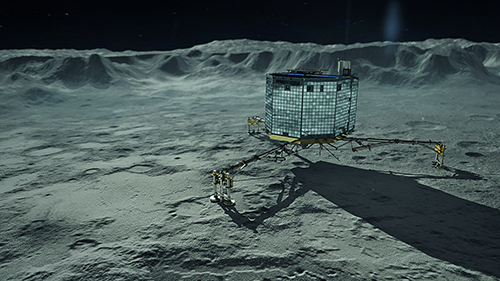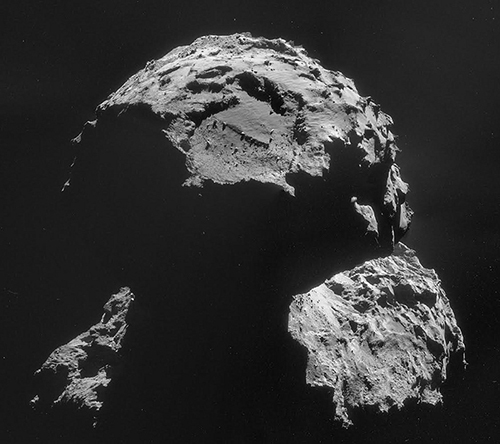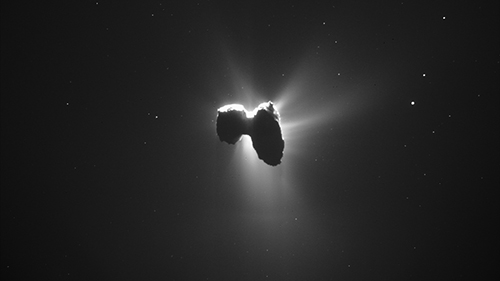Teaching with Rosetta and Philae Teach article
How a great achievement of the European Space Agency can become an inspiration for your students.
On 12 November 2014, after ten years of travelling together in space, the small robot Philae left the spacecraft Rosetta to land on comet 67P / Churyumov-Gerasimenko (67P). It was the first time in history that an expedition successfully landed on a comet.
The adventurous landing of Philae on comet 67P can be used to study Newton’s Laws, and students can use real data to work out the acceleration of gravity on the comet. I developed this project for students aged 15–18 who have already been taught Newton’s first and second laws of motion and who understand the theory of an object in free fall. You will need three teaching hours. In the first hour, introduce the problem and ask students to find useful information from the web. In the second hour, students find the acceleration of gravity on the comet using the laws of physics that they already know. In the third hour, students use simulations to find the acceleration of gravity on the comet. Finally, they compare the two different methods.

Image courtesy of DLR German Aerospace Centre; image source: Flickr
Hour 1: Introduction and data collection
- Show your students Ambition, a short video from ESAw1, and then present Rosetta and Philae’s latest achievement using videos and images from the ESA’s websitesw2,w3. Ask your students why they think this expedition is so important and what ESA wants to learn about comets.
- Present the simulation videow4 showing how Philae suffered a malfunction to two anchoring harpoons and so bounced twice before reaching its final destination on the comet 67P. Those two bounces are very important in this project to work out the gravitational acceleration of the comet.
- Organise the class into teams and ask them to search the web for information such as the mass of Philae, the velocity of its descent, and the height and duration of the two bounces. Your students should find that Philae left Rosetta 22.5 km above the surface of 67P. Philae reached 67P with a velocity (v) of 1 m s-1 and then bounced for 1 hour and 50 minutes, reaching 1 km in height with a velocity of 0.38 m s-1. The second bounce lasted 7 minutes with an initial velocity of 0.03 m s-1.
Hour 2: Working with the physical laws
- Ask your students about the motion of Philae as it descends towards the comet. Is it possible to divide the motion into steps? For example, students can think first of the free fall of Philae, then the first bounce as a constant deceleration, and then free fall again. The second bounce can be thought of in a similar way.
- Ask your students to calculate the acceleration of gravity on the comet using the data that they found in the previous teaching hour. If the students use the equation v = v0 – gt and assume deceleration with constant g (a homogeneous gravity field) then when v = 0, v0 = 0.38 m s-1 and t = 55 min (the total bounce time of 110 minutes divided by two), the acceleration of gravity on the comet will be approximately 10-4 m s-2.
- Ask your students to perform the same calculation using the second bounce of Philae. Their result should be of the same order of magnitude but not exactly the same value because the comet has an anomalous shape and its gravity field is not homogeneous (Sierks et al., 2015).
- Finally, ask your students what would have happened if Philae had fallen to Earth instead of the comet. What would be the duration of the bounces?

Image courtesy of ESA
Hour 3: Simulating the fall
The next step requires physics simulation software such as the Interactive Physics (IP) software, which is free for schools in Greece. If you cannot download this software or it is not freely available in your country, you can use the free Stepw5 software as an alternative. Whichever simulation software you use, we assume that your students are already familiar with it. If they are not, you should first spend an hour helping them understand how the software can be used.
- Ask your students to use the software to simulate Philae’s landing. They will need a small object to play the role of Philae and a bigger object to play the role of the comet. They can then play with the shape, dimension and mass of both objects.
- The students should start by modelling the comet as a sphere with a radius of 1 km (the largest dimension of the comet is 4 km).
- Ask your students to perform a simulation with a homogeneous gravity field of g = 9.81 m s-2 as on Earth.
- Tell the students to reduce the value of the acceleration due to gravity and to run the simulation again.
- The students should continue with the simulations after adjusting different variables. Eventually they should use the real mass for Philae and 67P as well as the comet’s true dimensions.
- In the final stage, the students should deactivate the homogeneous field and activate planetary interaction between the two objects. The force on Philae can be calculated as 0.066 N on the surface of the comet, giving an acceleration of gravity on the surface of 6.6 10-4 m s-2, because the mass of Philae is 100 kg. This value should be of the same order of magnitude as the results of the previous method and also very near to realityw6.
In my experience, students are enthusiastic about the project: two totally different methods give similar answers that coincide. The results are also very close to the real value of the acceleration of gravity. Students work as researchers, finding the necessary data from reliable websites as well as testing the parameters of the problem to find the acceleration of gravity on comet 67P using theory and simulations. Space science is very attractive but unfortunately is not included in the Greek physics curriculum in lyceum (for ages 15–18). This project is an opportunity to learn about ESA’s important achievement while still following the regular curriculum. Students use Newton’s first and second laws as well as the equations of motion for the free fall of an object before using Rosetta’s expedition, and more specifically the trajectory of Philae, to demonstrate a real-life example of the equations of motion. Students can also use their ICT skills to perform the simulations. In general, such a challenging problem gives inspiration to students.
It is possible to reduce the three teaching hours to two if you don’t have enough time. For example, you can skip the section where students search the web and instead give them the data directly. You can also adjust the project to work with students aged 12–14, for example by spending more time on the introduction and skipping the simulations.

Image courtesy of ESA
Acknowledgement
Part of this article comprised the main issue in an educational scenario that I submitted to the 2014–2015 Open Discovery Space Contest for the best learning scenario. My scenario received the pan-European prizew7.
References
- Sierks H et al. (2015) On the nucleus structure and activity of the comet 67P/Churyumov-Gerasimenko. Science 347: aaa1044. doi:10.1126/science.aaa1044
Web References
- w1 – To watch Ambition, a short video from ESA, visit: https://youtu.be/H08tGjXNHO4
- w2 – For more information about the Rosetta mission, visit the ESA’s dedicated Rosetta website: http://rosetta.esa.int
- w3 – Even more information on Rosetta and Philae can be found on the ESA’s education website: www.esa.int/education
- w4 – To watch a short video simulating Philae’s two bounces before landing on 67P, see: https://youtu.be/bpAH3DtRBjo
- Detailed information about the Rosetta mission can be found on Quora, a crowd-sourced question-and-answer website. See: http://tinyurl.com/h9f7sf2
- w5 – Interactive Physics is free for schools in Greece. If this is not true in your country you can purchase the software from https://www.design-simulation.com/IP/index.php
- To download the free Step physics simulator and the accompanying user documentation, visit: https://userbase.kde.org/Step
- w6 – For a news report of Philae’s successful descent onto 67P, see: http://tinyurl.com/hgya3ex
- w7 – The Open Discovery Space Contest 2014–2015 sought to develop innovative learning scenarios, foster new knowledge and create awareness in the education community. For more information about the contest and its participants, read: http://issuu.com/signosis/docs/ods-contest-brochure
Resources
- A version of this article that deals with the same topic, but is not a direct translation, has been published in the Greek-language magazine Φυσικές Επιστήμες στην Εκπαίδευση (Physical Sciences in Education). For more information, see: http://physcool.web.auth.gr/ or use the direct link: http://tinyurl.com/z8ljedw
Institutions
Review
Space exploration is a very rich subject and this article can be used in many different ways. For instance, the orbit and periodicity of 67P can be used to study the evolution of human knowledge about the motion of space objects, from Kepler and Galileo to Newton and Halley.
The article can be used for further insight into the concept of escape velocity and for discussions regarding the enormous distances involved in space travel, the inherent difficulty associated with human space travel, and ultimately, our position in the Universe and our loneliness in space – subjects that go well beyond science.
Duarte Nuno Januário, Portugal





